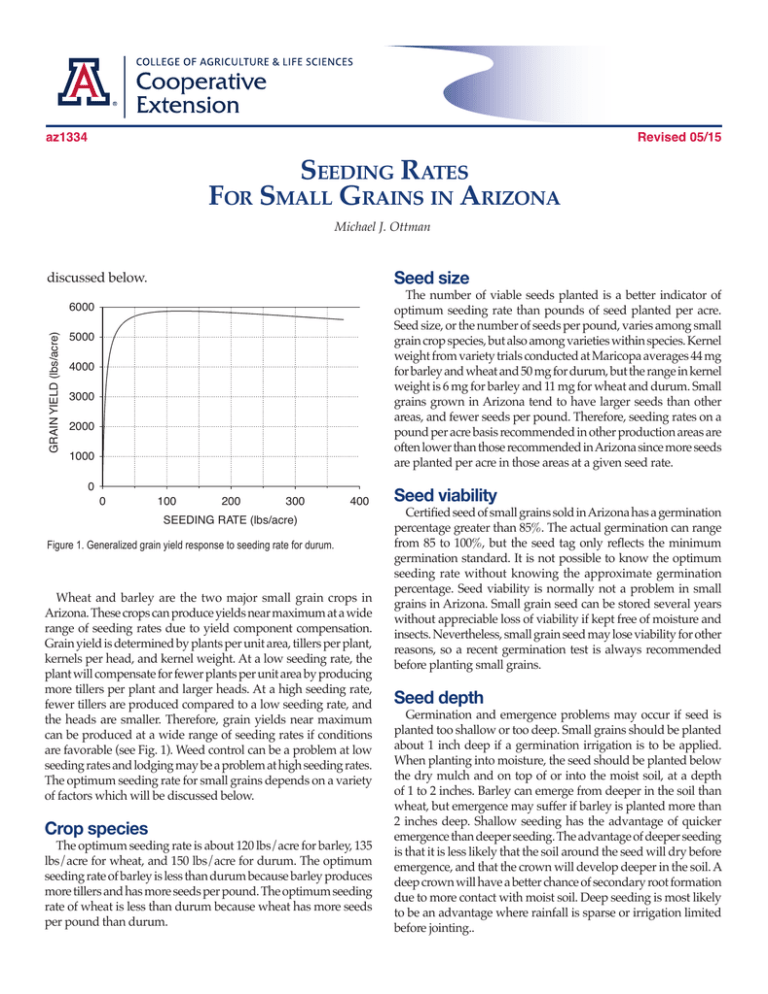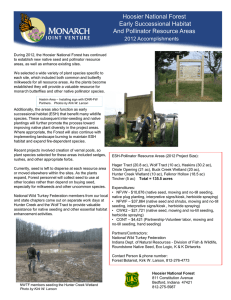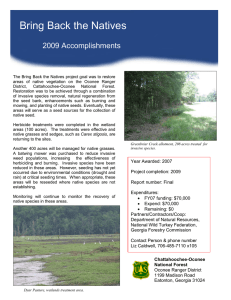S R F g
advertisement

az1334 Seeding Rates For Small Grains in Arizona Revised 05/15 Michael J. Ottman Seed size discussed below. The number of viable seeds planted is a better indicator of optimum seeding rate than pounds of seed planted per acre. Seed size, or the number of seeds per pound, varies among small grain crop species, but also among varieties within species. Kernel weight from variety trials conducted at Maricopa averages 44 mg for barley and wheat and 50 mg for durum, but the range in kernel weight is 6 mg for barley and 11 mg for wheat and durum. Small grains grown in Arizona tend to have larger seeds than other areas, and fewer seeds per pound. Therefore, seeding rates on a pound per acre basis recommended in other production areas are often lower than those recommended in Arizona since more seeds are planted per acre in those areas at a given seed rate. GRAIN YIELD (lbs/acre) 6000 5000 4000 3000 2000 1000 0 0 100 200 300 400 SEEDING RATE (lbs/acre) Figure 1. Generalized grain yield response to seeding rate for durum. Wheat and barley are the two major small grain crops in Arizona. These crops can produce yields near maximum at a wide range of seeding rates due to yield component compensation. Grain yield is determined by plants per unit area, tillers per plant, kernels per head, and kernel weight. At a low seeding rate, the plant will compensate for fewer plants per unit area by producing more tillers per plant and larger heads. At a high seeding rate, fewer tillers are produced compared to a low seeding rate, and the heads are smaller. Therefore, grain yields near maximum can be produced at a wide range of seeding rates if conditions are favorable (see Fig. 1). Weed control can be a problem at low seeding rates and lodging may be a problem at high seeding rates. The optimum seeding rate for small grains depends on a variety of factors which will be discussed below. Crop species The optimum seeding rate is about 120 lbs/acre for barley, 135 lbs/acre for wheat, and 150 lbs/acre for durum. The optimum seeding rate of barley is less than durum because barley produces more tillers and has more seeds per pound. The optimum seeding rate of wheat is less than durum because wheat has more seeds per pound than durum. Seed viability Certified seed of small grains sold in Arizona has a germination percentage greater than 85%. The actual germination can range from 85 to 100%, but the seed tag only reflects the minimum germination standard. It is not possible to know the optimum seeding rate without knowing the approximate germination percentage. Seed viability is normally not a problem in small grains in Arizona. Small grain seed can be stored several years without appreciable loss of viability if kept free of moisture and insects. Nevertheless, small grain seed may lose viability for other reasons, so a recent germination test is always recommended before planting small grains. Seed depth Germination and emergence problems may occur if seed is planted too shallow or too deep. Small grains should be planted about 1 inch deep if a germination irrigation is to be applied. When planting into moisture, the seed should be planted below the dry mulch and on top of or into the moist soil, at a depth of 1 to 2 inches. Barley can emerge from deeper in the soil than wheat, but emergence may suffer if barley is planted more than 2 inches deep. Shallow seeding has the advantage of quicker emergence than deeper seeding. The advantage of deeper seeding is that it is less likely that the soil around the seed will dry before emergence, and that the crown will develop deeper in the soil. A deep crown will have a better chance of secondary root formation due to more contact with moist soil. Deep seeding is most likely to be an advantage where rainfall is sparse or irrigation limited before jointing.. Initial irrigation The optimum seeding rate may vary depending on the initial irrigation. If seed is irrigated up with the initial irrigation, crusting is more likely and higher seeding rates may be needed than if an initial irrigation was applied before seeding and the seed is planted into moisture. Emergence may be greater when planting into moisture than irrigating up assuming the seed is not planted too deep and contacts moist soil.. Emergence Seed may be viable and germinate but not emerge. A crust may form and inhibit emergence particularly on certain soils or if clear and windy days follow planting. Crust formation may also be a problem when planting into cold soils, where seed germination and emergence are slowed by low soil temperature. A second irrigation before emergence may be necessary to soften a soil crust to allow the seed to emerge, even though the crust may be thicker and harder after the soil dries from the second irrigation. Normally, about 75% of the seeds planted emerge, but emergence often varies from 50 to 100% depending on soil and weather conditions. Emergence tends to be greater in soils that are warm at planting time and do not form a crust. Replanting decisions should be made by the emergence stage. The optimum stand for barley is about 18 plants per square foot and that for durum and wheat is about 22 plants per square foot. Emergence may be a problem in areas in the field that received too much or too little water from the emergence irrigation. Replanting decisions should be based on the number of seedlings that emerge, uniformity of emergence, yield decrease due to later planting, costs associated with replanting, reasons for the poor stand establishment, and the ability to correct these problems in the replant. Stand establishment The density of the plants that emerge and survive is a better indicator of optimum seeding rate than the number of viable seed planted per acre. Emergence is usually defined as when the seed leaf appears above ground, or when the seed row can be seen. Not all plants that emerge survive. Seedlings may be lost to diseases or insects, but this seldom occurs in Arizona. Seedlings may be lost or damaged by herbicide carryover. Some seedlings may also be lost to bird damage, which may occur for a certain distance along various seed rows depending on bird feeding pattern. In soils that shrink and swell, seedling roots may be exposed by cracks and the plant may desiccate. Even under optimum conditions, self-thinning of seedlings may occur, particularly at higher than optimum seeding rates. Stand establishment may be considered to occur at about the 3-leaf stage, before the onset of tillering. Stand uniformity Stand uniformity is one of the best indications of whether or not a seeding rate is optimum or the stand is adequate. The minimum plant density for small grains is actually quite low if the stand is uniform. We do not have a good way to describe a stand that is not adequate due to lack of uniformity, but a gap of more than 12 inches would probably result in yield loss. Increasing the seeding rate may or may not compensate for lack of stand uniformity. If 2 The University of Arizona Cooperative Extension lack of stand uniformity is due to too much or too little water in areas resulting from poor land leveling, seed metering or seed depth problems from the planter, or heavy crusting, then increasing seeding rate will not be beneficial. Rather, dealing with the causes of lack of uniformity would be a better approach. However, if lack of stand uniformity is due to light crusting or appears random, then increasing seeding rate may help. Many emerging plants in a seedrow may provide enough force to lift a crust that fewer emerging seedlings would not be able to break. Seeding equipment The optimum seeding rate is influenced by the seed placement of the planting equipment. Recommended broadcast seeding rates are generally 20% higher than when planting with a grain drill due to poorer uniformity, lack of depth control, the lack of proximity of neighboring plants to help in penetration of a crust, and the absence of the crack that forms in the seedrow from a grain drill that facilitates emergence. A grain drill provides an increase in seeding precision compared to broadcasting, but the seed is not metered very precisely and the seed depth may not be controlled very well. Pneumatic and other precision planters can meter seed very precisely, but this type of equipment is not commonly used for small grains. Planting date Seeding rate is often increased to compensate for decreased tillering that is expected with a later than optimum planting date. Increasing seeding rate with a delay in planting date is often recommended, but there is not overwhelming evidence to support this practice or to provide guidelines on how much seeding rate should be increased. Nevertheless, increasing seeding rate with delayed planting probably does not have any negative aspects other than increased seed cost. By way of contrast, high seeding rates when planted early can increase the risk of lodging and frost damage. High seeding rates can decrease straw strength and increase plant height, both leading to increased risk of lodging. High seeding rates increase risk of frost damage because fewer tillers are formed, and the frost susceptible stage of flowering is reached earlier. Also, if frost damage does occur with high seeding rates, it is likely to be more severe since a higher percentage of plants will be flowering at a given time compared to lower seeding rates whose tillers prolong the flowering cycle. Variety It is generally thought that varieties that are tall or produce many tillers tolerate a lower seeding rate. While this may be true in many cases, it is not necessarily always the case. It may be more accurate to say that taller varieties do not tolerate higher seeding rates because of susceptibility to lodging. Varieties that tiller well may indeed cover the soil surface at lower seeding rates, and compensate for a lower plant density by forming more productive tillers. However, some varieties may compensate for a lower plant density by producing a bigger spike or larger seed. Although we know that varietal differences in response to seeding rate exist, these differences may be small in many cases and we do not have enough data to define these differences and provide specific recommendations for each commercially available variety. We do know that the optimum seeding rate for Westbred 881 is higher than the now obsolete variety Aldura and maybe also many current varieties. The optimum seeding rate for the low input barley Solum is lower than conventional varieties due to its susceptibility to lodging, among other reasons. Planting configuration Seeding rates can be decreased if row spacing is widened. If seed is in short supply as in the case of seed increase, more yield can be expected at the same seeding rate if row width is increased. For example, 2 or 3 rows on a bed is preferable to drill seeding at a low seeding rate (25 lbs/acre). Beds also have the advantage of allowing mechanical weed control, and in the case of seed increase, rouging for off-types. In the Yaqui Valley of Mexico in the state of Sonora south of Arizona, growers have switched to planting 2 or 3 rows on a bed to allow mechanical cultivation to save on the cost of herbicides for controlling canarygrass and wildoats. In addition to herbicide savings, seed costs were cut in half. For this system to work, varieties must be used that are adapted to bed planting. Seed is relatively inexpensive, so reducing seeding rate is usually done for reasons other than seed cost. If small grain seed cost were substantially greater, as may be the case with hybrids or GMOs, then reducing seeding rates should be seriously considered. COLLEGE OF AGRICULTURE & LIFE SCIENCES Cooperative Extension The University of Arizona College of Agriculture and Life Sciences Tucson, Arizona 85721 Michael J. Ottman Agronomy Specialist Contact: Michael J. Ottman mottman@cals.arizona.edu This information has been reviewed by University faculty. extension.arizona.edu/pubs/az1334-2015.pdf Originally published: 2004 Other titles from Arizona Cooperative Extension can be found at: extension.arizona.edu/pubs Any products, services or organizations that are mentioned, shown or indirectly implied in this publication do not imply endorsement by The University of Arizona. Issued in furtherance of Cooperative Extension work, acts of May 8 and June 30, 1914, in cooperation with the U.S. Department of Agriculture, Jeffrey C. Silvertooth, Associate Dean & Director, Extension & Economic Development, College of Agriculture Life Sciences, The University of Arizona. The University of Arizona is an equal opportunity, affirmative action institution. The University does not discriminate on the basis of race, color, religion, sex, national origin, age, disability, veteran status, or sexual orientation in its programs and activities. The University of Arizona Cooperative Extension 3



